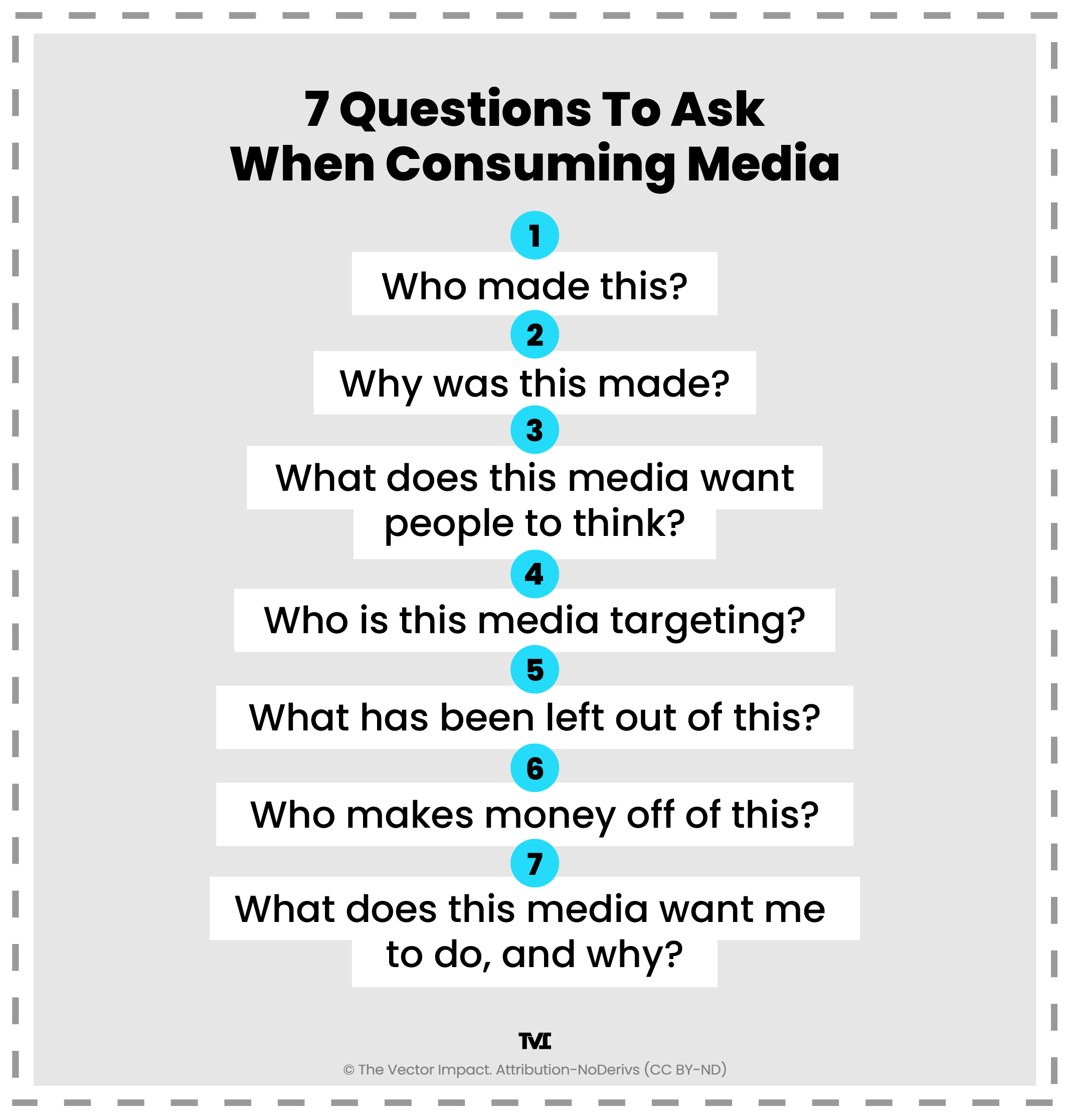
Last week, I was scrolling on Reddit when I came across a video of a politician giving a speech.
Below the video, the top comment read: “This is CLEARLY AI!” The person went on to explain how there were subtle hints in the video that signaled AI—shifts in lighting, awkward cuts between clips, and so on.
I watched the video again and again, to see if I could pick up the same signs the commenter had. But as I watched, I only became more confused.
Was it real or not?
This wasn’t a unique experience for me—and probably not for you, either, given that we’re both living in the age of AI and disinformation.
Despite having more access to information and communication tools than ever before, it’s becoming harder and harder to know what’s true, what’s opinion, and what’s fully manufactured.
Being able to discern fact from fiction is an essential part of the human experience, so it’s important to develop skills that will help you know what’s trustworthy and what deserves more scrutiny.
The practices in this article will not only help you navigate the media landscape but also equip you with skills that are essential for college and many career fields beyond.
1. Keep an open mind, but a skeptic’s eye
Let’s start with the general mindset you should have whenever you’re engaging with fact-based media.
It’s important to ask questions about the things you read and see. Here are a few simple ones you can have on hand:
Remember that even the most rigorous journalists make mistakes, and if you dig deeply enough, you can find examples of every single news organization distorting facts and showing bias, whether it’s intentional or not.
But if you ask the right questions and perform genuine research alongside your media consumption, you’ll soon learn which news sources are less likely to make these mistakes, and are therefore more trustworthy.
Skepticism vs. Conspiracy Theories
While a certain amount of skepticism is important, you don’t want your mistrust of news sources to steer you toward false conspiracy theories.
People can believe in conspiracy theories for many reasons—among them, the fact that some conspiracy theories have turned out to be true after all. For example, it’s true that the NFL tried to cover up the relationship between football and brain damage, as revealed by this Frontline investigation.
In other cases, people choose to believe conspiracy theories because the truth is too painful, scary, or confusing to accept. People find black-and-white thinking easier to stomach than the nuanced approach required to understand complex situations.
On top of this, there are bad actors actively pushing conspiracy theories on virtually every social media platform, making it easy for skepticism to veer into conspiracy territory.
In addition to the tips I cover in this article, I highly recommend using this 7-step process from The Conversation on how to figure out if a conspiracy theory is true or not.
2. Look for the direct source
When you read something in the news that presents new information, the very first thing you should do is try to find the source.
Take a few minutes to answer this question: Where did this information come from?
If you came across the information in a credible news source, then they will cite their sources using industry standards, which makes it easy to check your source.
For example, when a legitimate journalist quotes someone, they will tell you who exactly said the quote (or explain how they verified a source that remains anonymous). When they cite a fact from a study or research paper, they reference or link to the publication that put forth that study.
Pay attention to the words and links people provide when citing their sources. Direct quotes, eye-witness statements, legal and government documents, and verified videos and photographs are always more trustworthy than a quote that ends with something like, “a friend of the actor told us.”
To illustrate what I mean, let me walk you through the research and thought process I used when creating this very article.
I selected the link to the Frontline report in the section above like this:
- First, I used Google and AI to find examples of conspiracy theories that turned out to be true.
- That led me to this article, from a site I’ve never heard of, which meant I needed to do more research.
- I looked and saw that the source I’d found was in fact linking to a different source. I visited their links to see where they were getting their information
- When I clicked on the name “Bennet Omalu,” that led me to the Frontline article.
That was the end of my search, because…
- The Frontline article has direct quotes and video from the doctor involved
- Frontline is a production of PBS, which has rigorous journalistic standards that I have already looked into and trust
This took me a total of about 4 minutes, and I probably wouldn’t have gone through all of that if I was just reading casually. But when you are reading specifically because you want to know what’s true (which is always the case when I’m writing for the public), then those extra few minutes can make a huge difference in the veracity of the information you receive and share.
3. Get to know your news sources
Take a look at this tool from the Pew Research Center, which shows which news sources people use and find most trustworthy.
Play with the different age and political filters on there, and it won’t take you long to see that there are some huge differences in which sources people trust. If there is this much disagreement among the public, how are you supposed to know which news sources to believe?
The answer is to do your own research and exploration into the sources themselves. You can easily look into:
- The journalistic standards of the source. Most have this published on their website, and they should be very rigorous.
- The people who run these media companies. Most are public figures, and you can read about their personal beliefs and political affiliations online.
- The company’s history of reporting. How well established are they? Have they won awards? Do they have any recent/major scandals?
Take it slow—you’ll need to be checking your sources as you go. Yes, that means checking the sources of the sources you’re checking! 😵💫
Try picking just one news company to explore each week. Click around and read their stories, and review the background and standards of the company. Do this until you’ve sampled a number of different news sources, and you’ll start to get a feel for whose news you find to be most trustworthy.
4. If your emotions are rising, pause and take a break
The purpose of a news headline (or a social media caption) is to catch your attention and hold it.
Newspapers put their headlines in bold, dramatic text. Tiktokers start their videos with the most shocking five-seconds of footage. Radio broadcasters open their reports with a line that makes it impossible to stop listening.
These creators and algorithms know that they are more likely to keep your eyes and ears on their platform if your emotions are turned up.
If you see a headline or hear a clip that makes you frightened, shocked, disgusted, or angry, then you’re far more likely to keep reading or listening or scrolling (and therefore, more likely to drive ad revenue, which most media companies need to survive).
Think of your emotions as a barometer for news trustworthiness. If you feel yourself getting riled up, odds are that the media you’re consuming has been designed to do just that. New sources that intentionally manipulate your emotions with sensational headlines and clips are not to be trusted.
On the flip side, when your emotions are ramped up, fact-checking goes out the window. People react quickly and often irrationally when they have strong feelings—it’s why you type out that angry comment at the bottom of a post, then regret it later when your emotions have died down.
The best thing you can do when you feel your emotions boiling over is to stop and walk away. Turn off whatever device you were using to engage with the media, and try going outside for a walk or talking with a loved one instead.
When you’re ready, go back to the story and read more than just the headline. Then, check other sources to see how they are reporting it. If you do this, you’ll remove the heightened emotions and get a clearer, more level-headed look at the truth.
5. News takes time to develop—it’s ok to wait for the facts
Thanks in large part to social media, there is a lot of pressure for people to form quick and strong opinions. Folks want to have the hottest, fastest, most extreme take—and people who express uncertainty or skepticism are often ridiculed or shamed.
But the people who should feel ridiculous are those who jump to conclusions before all of the facts have come out. Despite how quickly news seems to happen, it takes time for investigators and journalists to do their jobs well. Patience is required.
If a news event has just happened, you should dial up your skepticism when reading reports of events. In most breaking-news cases, the facts aren’t fully known for hours, days, or weeks after the event itself has taken place. Details reported early on can end up being incorrect or misleading.
This is an especially important matter for fake news on social media, which you can find on any platform. Not long after social media became a thing, people figured out how easy it was to spread false information by drafting an emotionally charged and factually incorrect post.
Social media platforms are also breeding grounds for speculation, misinformation, and emotionally charged arguments. As tempting as it may be to join in, if you’re truly hunting for facts and truth, you aren’t likely to find them in comment sections or Reddit threads full of people who only read the headline.
To make this issue even stickier, we now have AI that can create images and videos that are virtually indistinguishable from reality. Fortunately, most legitimate news organizations have teams and tools that can help us distinguish AI footage, but once again—it takes time. If you see a shocking video or image, but it hasn’t been verified by any news sources you trust, then it’s best to hold your judgment until you’ve got more information.
Finding truth takes work, but it’s worth it
All of this research and skepticism is hard work. If you feel exhausted and overwhelmed, that’s normal—this stuff is exhausting and overwhelming!
But practicing the skills in this article will make it easier over time. You’ll soon have sources you can trust, you’ll be able to check facts and sources faster, and you will be less likely to rush to conclusions without sufficient information.
This kind of research and consideration will serve you throughout your life. You’ll need it when you’re researching papers in college, putting together a project at work, or planning your own career.
Put in the work now to enhance your media literacy, and you’ll have the skills you need to cut through the noise and find truth wherever you go.









